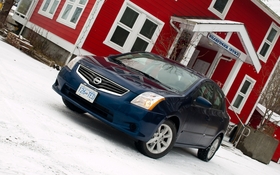2012 Nissan Sentra: Sentrasational, or Sentragnant?

| Strong points |
|
|---|---|
| Weak points |
|
There are few segments in the automotive marketplace that are as hard fought as that of the economy car. It's a segment that's dominated the sales charts since its inception and is oftentimes seen as the proverbial doorstep to brand loyalty. As a result, manufacturers scratch, claw, scramble and cling to any sort of advantage that they can claim over their competitors; be it interior space, fuel economy, or (gasp!) horsepower. But when it comes time for the rubber to meet the road, I've often found those trite little snippets of automotive fact to vary in usefulness from slightly distracting to downright misleading. So it's probably a good thing the Nissan Sentra doesn't lay claim to any of them... at least as far as I can tell.
Remaining in its sixth generation for the 2012 model year, it's impossible to deny that Nissan's little sedan is starting to feel a little sedentary. With nary a change to be found on the car's admittedly handsome little exterior nor beneath its angular hood, the new model relies on a few new variations of its optional trim packages to recruit fresh buyers, with perhaps the most important being the availability of the Technology Package on the lower-rung S trim. Additionally, the Moonroof, Technology, and Special Edition packages unveiled late last year continue into 2012 unchanged.
In the face of all that sameness, it's hard to tell what exactly the Sentra hopes to accomplish in a field that now includes everything from hybrids to self-parking wündercars. With a 2.0 litre four cylinder putting out a pretty pedestrian 140 horsepower and 147 foot pounds of torque, it certainly doesn't make a name for itself as the class powerhouse. Additionally, although it's optional CVT transmission does provide the perfect compromise between power delivery and fuel consumption, the constant rubber band effect it imbues upon any form of acceleration serves to make the Sentra's already stagnant performance fall even flatter. Combine that with the numbly nimble steering, and you get a car that resolutely ignores any attempt to making driving fun; something of a shame given the Sentra is the heir apparent to the long-forgotten Datsun 510's crown.
But, for all its corduroy pants and tweed jacket-invoking performance, the Sentra does provide a worthy counterpoint: the almost Soviet levels of solidity within its superstructure. I've always found the Civic and Corolla to be particularly lacking in this area, as for too long they've been saddled with an unfortunate mix of soft, easily-scratched, and poorly fitted plastic interior panels fastened to a steel structure that feels undeniably cheap. In contrast, the Sentra's interior, although spartan, feels quite well made. The plastics are all similar to what you'd find in Nissan's Altima and Maxima sedans, and don't scratch or scuff nearly as easily. Also, there's enough steel, fabric, and sound deadening material fastened to the door and its surrounding structure that its closure is accompanied by a solid thunk, rather than a hollow ringing sound. Granted, I'll be the first to admit that the sensation of solidarity imbued by a door's closure may have little to no bearing on its overall quality, but it is nice when it feels a bit more bank vault than screen door.
And although it might not have the visual flash and pizzazz of nearly any of competitors' interiors, it's still a very comfortable place to be. All the controls are precisely where they should be, and feel just about as good as they do in the Sentra's competitors. The only place that I'd draw some attention to is the awkward placement of the seat heater switches and the relatively cheap membrane switches that control the optional navigation/stereo system. That being said, it doesn't seem fair to complain about the seat heater switches without also mentioning that they activate some of the most potent seat heaters I've ever experienced, and although the stereo controls aren't exactly luxurious, they do offer a fantastic iPod interface that precisely mimics the menu structure and navigation methods of an iPod. Again, it sounds simple, but you'd be surprised at how many manufacturers seem hell bent on reinventing the iPod's wheel, rarely for better and often for worse. Of course, many of those same manufacturers also insist on having their USB jack positioned somewhere that's obviously visible, a real bummer when you're parking somewhere in Surrey; the momentary and former holder of the dubious title "North America's most auto-crime riddled city." But not so with the Sentra's center-console storage bin mounted jack.
In this fashion, the Sentra proves itself an incredibly simplistic, but very well thought out little car. It doesn't claim to be a barn-burning, heart-wrenching, smile per mile machine, nor does it stand on principle and claim to consume little more than second hand gasoline vapours while emitting purified mountain spring water and endangered dolphins from its tailpipe. As a result, Googling "Nissan Sentra" alongside the phrase "class-leading" will reward you with absolutely nothing but evidence of Google's willingness to join the term "Sentra" with "5.6L V8." However brilliant that idea may be, it simply proves the point that a car, even of the economy variety, is so much more than a series of easily measured metrics. Sure, it'll arrive a few seconds behind some of its competitors, and it might cost you a few bucks (literally, a few) more per year to fuel, but trades best-in-class specialization for overall practicality, and as a result it does a simply stellar job of completing not just one, but each and every task an economy car is supposed to.











